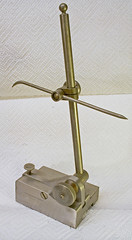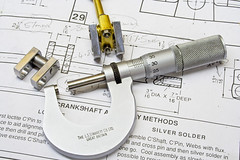Engineers Tools
My workshop is a mixture of old, very old, and some shiny new tools.Some of the tools are the ones that I have collected over the years when working at various companies.
I always used to buy and use my own sets of tools.
If you use your own tools you look after them, and you get a feel for them and how they are used.
I count the measuring instruments that I have as tools.
Not forgetting the hammers, screw drivers, scrapers, files etc.
Hand Tools
Rule, Hacksaw, files, drills, Hammer - you can make pretty much anything with these tools, it might take a long time, but I have seen some amazing things, made with just these hand tools.To these we can add, chisels, punches, scrapers, spanners, vices, soldering irons, abrasives, sharpening stones, hand shears, scissors, scribing blocks, V blocks, surface tables, clamps.
The most useful tools
What are the most useful tools, what are the tools that I would rather not, do without?
Machine Tools
This is where the fun begins, and the pocket empties. My most valued machine tools:Lathe, Bench Grinder, Mill, Powered Hacksaw, Linisher, Bench Drill, Electric Hand Drill, Cordless Hand Drill, High Speed Hand Drill.My favorite ones I will talk about in their own sections.
A Rotating Tool Rack
Cheap and easy to make, a piece of ply drilled and slotted, to suit the tools you use, a bit of dowel for the upright, and some sort of bearing on the top, and a piece of scrap steel for the base.
One modification that I would make for a new disc is to make the file slots with closed ends as the files can slip out sometimes, but this is only a minor problem. Lots of different size holes drilled through the disc, for screwdrivers, chisels, etc. Lots of cup hooks and any other types of hooks and screws around the edge to hold all those little tools you can never find, especially good for those little spanners. I sort my spanners in order of size from time to time, doesn't seem to stay that way long though. One of these racks carries a large amount of tools, and it means that they are easy to find and close at hand. Another modification could be to make a larger base, which could of course hold even more goodies, like nuts and bolts screws etc.
My Mini Workbench
I don't know the proper name for this piece of kit, but it is most useful, saves an incredible amount of wear and tear, on the main bench.It's quite often the only bit of free space to work on anyway :-) Just a piece of scrap softwood with a V notch cut into it and bolted to the bench, sticks out about 4" to 6". Replace when worn out, which takes quite a while, much cheaper than replacing a bench or part of a bench .I find the V notch configuration most useful for the bits and pieces that I do, but you can change or add different shapes or holes to suit yourself.
Engineers Scribing Block
A tool that many apprentices made in their training days, and a very useful hand tool too.
Setting castings or items in the 4 jaw chuck is made much easier by using this device, even without a dial gauge indicator attached.
surprising accuracy can be achieved.
When used in conjunction with a surface table, or a flat piece of glass, accurate marking out is easily achieved.
Can be used in conjunction with "engineers slips", either with or without a dial gauge indicator, to measure to great accuracy.
Using the scriber block without a dial gauge, does entail the feel factor, which is a skill only achieved by time and use. The sense of feel is a skill which any time served engineer will posses, a very tactile and extremely accurate sense, and one well worth cultivating.
Engineers Slips
Basically very accurately ground and fine finished metal blocks.
The blocks come in a range of sizes, and can be used together to provide extremely accurate measuring devices.
A dial Gauge Indicator is most useful when using Engineers Slips.
Used for all sorts of very accurate measuring.
Digital Vernier Calipers
Digital Vernier Calipers
These are now available very cheaply, and they are extremely accurate. The item shown here, was only £9.90, so I bought several.
Do not get these device wet, they don't like it, this is one of the main differences between the high quality calipers and these, the other being the quality of the workmanship.
Still a useful and versatile tool.
Imperial Micrometer
Metric Micrometer
Micrometers
What a wonderful piece of equipment.
Micrometers are essential for any workshop, they are more accurate and robust than any Vernier Calipers.
The Digital Versions are easier to use than the older type, they also make for less mistakes, but I still enjoy using the older type, as they feel better in use.
Take the time to learn the use of whichever type you choose, and treat them gently in use, this skill will repay itself over and over again.
Tap and Die Set
Tap and Die Sets
Quite early on, you will find a need for taps and dies and one of the cheapest ways of buying them, would appear to be buying a boxed set.
This is not necessarily true, it might be better in the early days just to buy the taps and dies that you need, it quite unusual to use all of the taps and dies in a boxed set
Although a set of BA taps and dies rarely goes amiss :-) and possibly these days a set of metric taps and dies.
Care needs to be taken as the cheaper sets may be Carbon Steel rather than High Speed Steel.
Carbon still is much more brittle than high speed steel.
Breaking a tap in a work piece is an expensive and pointless thing to do, especially if it just to save a few quid on taps or dies.
Pine Vise
Pin Vices
Pin vices are extremely handy little tools, for any workshop and especially hand for model makers as they allow you to hold small parts firmly but with out damage.
The top Pin Vice shown is holding a diamond burr or point, I was using this to de burr the holes drilled for the Crankshaft Pins of the D10 Steam Engine.
Also handy for holding swiss files.
I have used these held in my drill/lathe chuck, to hold small parts for polishing.
Well worth purchasing, once you have a pin vise, you wonder how you managed without one.
Thread Gauge or Thread Pitch Gauge
Thread Gauge or Thread Pitch Gauge
A useful tool that enables you to find the pitch and thread form of a screw thread or tapped hole.
The thread gauge shown is a very old set rescued at a car boot sale, it's had a hard life but still works fine.
You place the feelers of the gauge on the thread that you are checking and when you get a match you can read the thread and pitch on the gauge blade.
Tap Wrenches
Tap Wrench
Used with taps for tapping or threading a hole or a nut. These are 2 small Tap Wrenches which you would use up to about 6mm thread which covers quite a range of model sizes. The top most version is the one I use the most, it holds the taps more firmly and is a nicer shape to use.
Drill and Tap Set MM
Boxed Set of MM Drills and taps
Keeps all of your MM taps along with a set of tapping sized drills, a good buy for anyone starting up in Model Engineering.
Some don't like these kits of drills and taps preferring to buy taps and drills individually for specific jobs, which is fine if you live near a tool supplier, but it makes it awkward if you don't.
I would suggest a boxed set of MM drills and taps, and if you are dealing with older models a boxed set of BA taps and dies you can add the more specialized taps and dies on an individual basis as they tend to be more expensive.
Always remember when tapping be gentle, if you think you are going to break a tap - then you probably will. Stop before you do and drill the hole fractionally larger or deeper to suit.
Breaking a tap in a job is not fun at all and it can take much effort to remove the broken pieces. However most of us have broken a tap from time to time.
Dial Gauge Indicator
Dial Indicator Gauge - Clock Indicator
These are known by several different names, they are incredibly useful for checking and truing, no workshop should be without at least one of these devices.
You can true a job in the lathe or Milling machine, test for accuracy, align a vice on a mill, check for roundness or square.
There are many digital versions about which are fairly cheap, but I prefer an analogue type for lining things up or setting a machine vice.
Magnetic Base Gauge Holder
Magnetic Base Clock/dial Gauge Holder
These are new on the market and are extremely useful, especially in those tighter corners.
You can of course use the Magnetic Base to hold all sorts of bits and pieces. I'm planning to use this tool as a photo aid for holding small parts at a suitable angle for imaging.
The one thing that you must be careful about: is tightening the knurled clamping wheel carefully, it can loosen when you push the arm down, bouncing your delicate Dial Gauge Indicator of any handy bit of steel to it's detriment :-)
The magnet is extremely powerful and holds the inserted tools firmly in place.
Clamp Type Knurling Tool
Clamp Type Knurling Tool
Use these in preference to the straight type Knurling Tool, as far less detrimental pressure is placed on your lathe Head Bearing and Lathe Saddle.
They are more expensive especially as they get larger.
Could make a nice project to Build your own version.
Collets and Holder
Collets and Holder
Collets are of great use for accurate machining they hold jobs or tools much more accurately and firmly with out inflicting surface damage and/or bruising.
I have several sets of collets for use with both the lathe and the milling machine.
Collet Types appear to be a very personal choice and there are different types and designations about. I use ER25 collets a lot and find them very useful as they provide flexibility of sizing. Allowing a smaller range of collets to grip many different sizes.
The cheaper chinese made collets and holders are very good value for money especially for the early days, if you want greater accuracy go for the more expensive varieties and types.
Engineers Slitting Saws and Holder/Arbour
Engineers Slitting Saws and Holder/Arbour
The holders for these saws usually come with a variable size blade holding arrangement - so one holder will hold a range of different size blades.
If you need very accurate cutting, make up your own Holder/Arbour just to take the size that you want to use.
With a bit of imagination these handy cutters will help with a multitude of tasks.
These can be used both in a Lathe and/or a Mill, some engineers make up sawing tables for use with these.
Slitting Saw Blades
Slitting Saw Blades
A few examples of the types of slitting saw blades that are available.
Some blades have side cutting capability some don't. Side cutting is not really recommended on the smaller mills unless of course - done very carefully :-)
Remember that Model Sized machinery will do pretty much anything a full sized machine will do - but it takes patience and time.






















